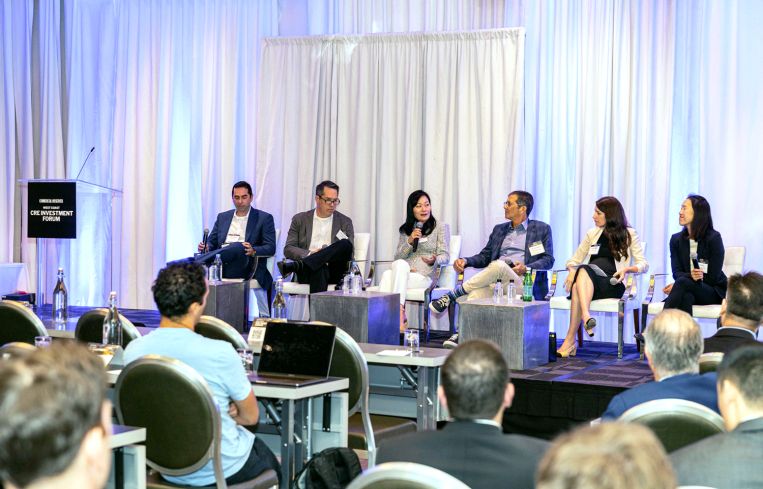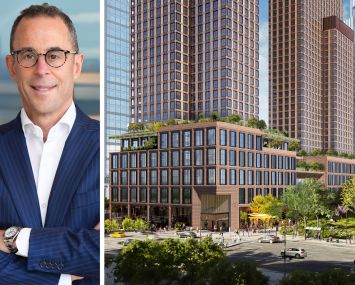Southern California Commercial Real Estate Confronts Uncertainty: Forum
There was some optimism at a recent Commercial Observer gathering in Beverly Hills, but then the national economic climate showed up
By Patrick Sisson October 31, 2023 12:56 pm
reprints
On a jealousy-inducing, sunny fall day in Beverly Hills, dark shadows were nonetheless cast on the current development environment in Los Angeles and Southern California as a whole.
At Commercial Observer’s “West Coast CRE Investment Forum” Oct. 30 at the SLS Beverly Hills Hotel, industry players painted a picture of limbo and uncertainty on the national stage, with Southern California’s high costs and regulatory environment making an already challenging situation much worse.
“Capital doesn’t like surprises,” said Glenn Sonnenberg, president and CEO of LaSalle Debt Investors, during a panel on finding financing in today’s volatile markets. “In SoCal, there’s a lot of surprises and a lack of stability.”
Many speakers said the protracted challenges hampering commercial real estate’s full recovery — including high interest rates, locked-up funding and financing, and difficulty kick-starting ground-up construction — have been made worse by Measure ULA. That 5 percent transfer tax on real estate deals worth at least $10 million, which voters passed in 2022, is supposed to fund a broad suite of efforts to fight homelessness and high housing costs.
Many forum speakers took shots at what they described as the red tape and regulatory risk wrought by Measure ULA. It’s already been underperforming in terms of revenue estimates due to low transaction volumes, and the legislation is squarely blamed for a significant cooling of construction.
“Nobody wants to build here,” said Michael Regan, managing director of investments at developer CIM Group, speaking as part of a panel about capitalizing on distressed opportunities. “ULA knocks off a bunch of your profit. Supply will be muted on a go-forward basis.”
While there were rays of sunshine, including continued demand for industrial product in the nation’s most important logistics hub, many of the day’s speakers echoed their frustration over recent political changes, including ULA, recent rent control measures and moratoriums, and a statewide measure asking firms to report their carbon emissions and climate risks. Pacific Urban Investors Managing Director Ash Baraghoush said that some of his “competitors have redlined L.A.” because of political discord over development policies.”
This backlash over referendums and local laws overlapped with existing market difficulties, especially the financing drought impacting so many developers and owners. Kyle Jeffers, CEO at Acore Capital, said that, until rates are fixed, “you’re sitting on a market that’s essentially frozen.” This was largely the accepted wisdom of fellow panelists Baraghoush and Caroline Wu of analytics firm Placer.ai, even if Concord Companies’ Samuel Landman sounded slightly more philosophical about future development.
“There are 40 million people here — people are going to keep coming,” said Landman, Concord’s chief investment officer, expressing long-term belief in Los Angeles and California. The panel was moderated by Shally Hu of Ariella Capital Group.
But more of the real estate pros in attendance were eager to voice concerns about their ability to get big projects completed to keep up with demand.
During a fireside chat with Don Peebles, founder and CEO at developer The Peebles Corporation, and Kofi Nartey, the CEO of GLOBL Real Estate and Development, Peebles said he believes things will get worse before they get better. Hiis firm’s $1.6 billion Angels Landing megaproject downtown has faced increased challenges due to the city regulatory regime.
During a morning session, “Financing Your Deal: Finding Capital in Volatile Markets,” participants sketched how the market has locked up: There’s a significant disparity and disconnect between public and private valuations, billions of dollars of capital is on the side, and there’s a shortage of funding for new construction.
During the panel, Jason Choulochas, managing director of originations of Bank OZK, said his firm aims to get $8 billion out the door this year. It’s a challenge to do that many deals in this market, he said, yet “never underestimate developers’ desire to develop.” With lending slowing way down, Choulochas said his firm has been able to pick up the slack.
For a number of quarters now, there have been predictions of a bounceback, though most panelists felt things won’t truly stabilize until later in 2024. They said it’s part of a multiyear process that’s led many to seek to set themselves up for success in terms of prepping a pipeline and waiting. Sonnennberg said once things stabilize, it “will be like someone spiked the punch bowl, and deals will get done.”
Also on the financing panel was Invesco Real Estate’s Teresa Zien, Ares Management’s Danielle Duenas, and Christine Kang of Clarion Partners. Daniel Liffmann of law firm Mayer Brown moderated.
That delay in deals also includes distressed assets. During an afternoon session, “Capitalizing on Distressed Opportunities: How Savvy Investors Are Positioning Opportunistic Capital,” panelists said the market was preparing, not executing, around distressed properties.
Jennifer Halvas, managing director of investor relations at investment and development firm Cityview, said her firm’s investors want Cityview to take a wait-and-see attitude and make plans to take advantage of the market. Lots of deals for rescue capital are being and will be made — trillions of dollars in loans will mature through 2026 — and lenders are slightly more flexible. This is especially true for deals on the cusp, since they don’t want to take on more assets right now. Michael Regan of CIM Group and Spencer Schlee of Canyon Partners Real Estate joined Halvas. Darwin Huang of law firm Kasowitz Benson Torres moderated.
Even industrial, which has shined for years now amid SoCal’s woes, isn’t all rosy. During the “Industrial Revolution” panel, it was clear that, while demand is still quite strong, with new development and needs along the Mexican border spurred by reshoring and the development of fresh light manufacturing, challenges lay ahead.
Roughly 900 million square feet of industrial is in Los Angeles, but just 9 million square feet is delivering in the next year, which will keep rents high and vacancies low. Tenants, hit hard by rising costs, have struggled, said Mason Waite, managing director of asset management for BKM Capital Partners, who appeared on the panel with Greg Skaler of Elion Partners.
“They’re getting squeezed at all levels,” Waite added, “with all input costs going up.” But he said he sees significant upside, both because of massive federal investments from the infrastructure bill, the Inflation Reduction Act and the CHIPS and Science Act.
There were plenty of other bright spots amid a larger consensus about local and national challenges. Commercial Observer’s West Coast Impact Awards celebrated regional developments highlighting the great potential of pushing through the challenges and red tape.
Sandy Sigal, retail and tech titan of NewMark Merrill, won the West Coast Impact Award; Related Companies won for its Grand LA multi-use megadevelopment; Hillwood took home Deal of the Year for its $559 million, CBRE-brokered deal to turn an industrial park into the Speedway Commerce Center; Worthe won Studio Lease of the Year for the Frank Gehry-designed Second Century, an adaptive reuse of an old Warner Bros.’ lot; and Bank OZK took home the Dealmaker of the Year award.
During a closing speech, the Los Angeles Rams’ Chief Operating Officer Kevin Demoff explained how the football franchise helped create a massive new live-work-play district centered on the new SoFi stadium, and how a business-friendly climate in the city of Inglewood played a big role.
Keeping Angelenos in Los Angeles, and keeping development moving at a speed and scale to accommodate them will require effort from elected officials to repeal or rework regulations, such as California’s Environmental Quality Act. Such regulations stand in the way of development, according to participants at a late afternoon panel about affordable housing and multifamily development. Many said they’d left an excessively regulated L.A. proper behind, focusing instead on surrounding areas such as Ventura and Orange counties. Without more action, they said, L.A. would lose some of the spark that drew so many there.
In the panel “Making Southern California More Real Estate-Friendly Through Multifamily and Affordable Housing Development,” all the panelists — Joseph Soleiman of Vivo Investments, Jared Goldstein of Canfield Development, Wes LaBar of TruAmerica Multifamily and Henry Manoucheri of Universe Holdings — said that they were not building ground-up or buying in L.A. at the moment but instead were looking on the periphery. This is despite extremely good fundamentals in L.A. such as high rents and low vacancy.
“We need commitment from politicians to welcome businesses into the city,” said Schlee of Canyon Partners, a firm founded in L.A. that had recently opened a new office in Dallas. “It’s important to note that we’re competing against the entire country.”


